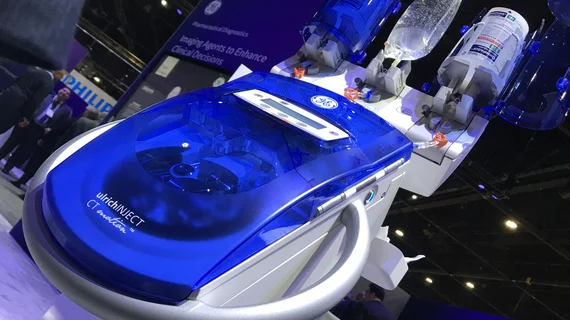Multi-use syringeless injectors could completely eliminate contrast waste
By switching from single-use to multi-use syringeless injectors (MUSI) to administer contrast media during CT exams, radiology departments could substantially reduce their material waste.
A group of experts at the University of Wisconsin School of Medicine and Public Health recently conducted an in-depth comparison between the two injectors to get a better understanding of how each affected the radiology department’s time spent preparing for exams and the amount of materials included in doing so (contrast, saline, plastic, etc.). Overall, the group observed a reduction in time and material waste on almost all fronts, and the switch was well received by technologists.
The details of their work were shared recently in Academic Radiology.
Multi-use injectors typically make use of plastic containers with around 500 ml of contrast in them—significantly more than single-use injectors that usually average around 100 ml per bottle. Multi-use injectors eliminate the need for single-use syringes while also reducing how frequently plastic bottles of ICM must be changed once the entirety of their contents has been used. These injectors present many opportunities to reduce waste, corresponding author of the new paper Giuseppe V. Toia, MD, MS, with the Department of Radiology at University of Wisconsin School of Medicine and Public Health, and colleagues suggested.
“Prior work has shown that syringeless injectors more efficiently reduce contrast waste while maintaining diagnostic contrast enhancement,” the team explained. “Injectors using less ICM should decrease associated plastic consumable waste and overall be environmentally impactful.”
For their analysis, experts observed CT technologists over a three-day period using both single-use and multi-use injectors; exam preparation times and materials used were compared, and techs were surveyed on their experiences with each system afterwards.
Switching from single-use to multi-use injectors shaved approximately 40.5 seconds off each exam. The team estimated that over a 16-week period, this would reduce ICM waste from 31.3 L down to 0.0 L and plastic waste from 467.7 kg down to 71.9 kg.
Multi-use injectors were rated higher by technologists for work efficiency, user-friendliness and overall satisfaction.
Not only do multi-use injectors present financial advantages by reducing plastic and ICM waste, the group noted, but they also could increase departmental efficiency and advance environmental initiatives in radiology.
“The encouraging data suggest that MUSI aligns with green radiology best practice initiatives in reducing overall departmental waste,” they wrote. “Secondarily, MUSI may offer time savings benefits allowing CT technologists to focus on other clinical tasks.”
The study abstract is available here.

